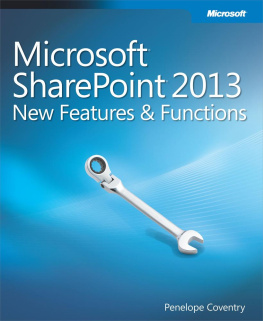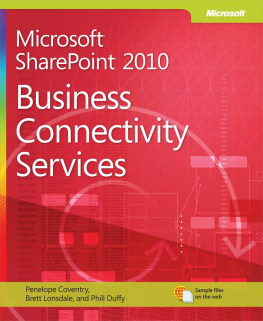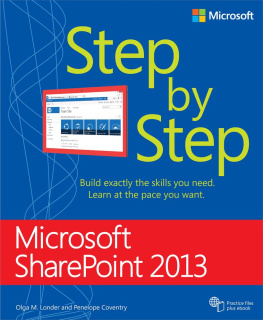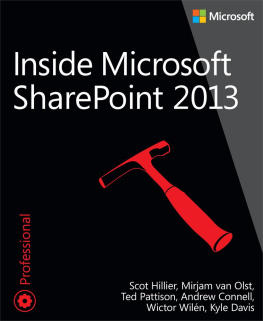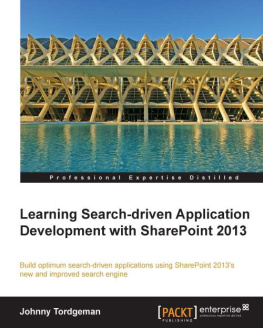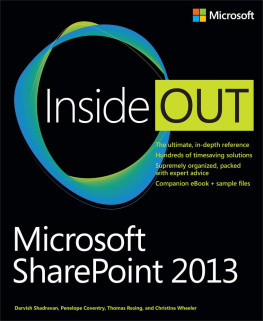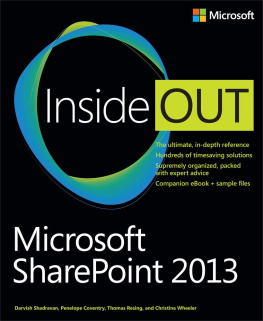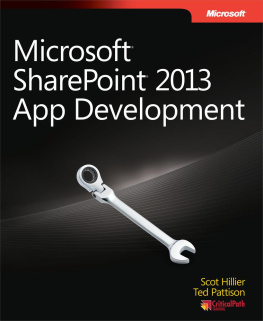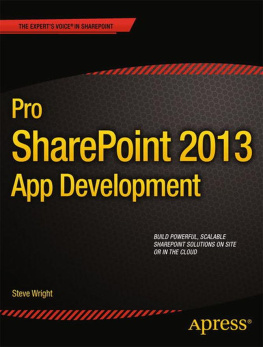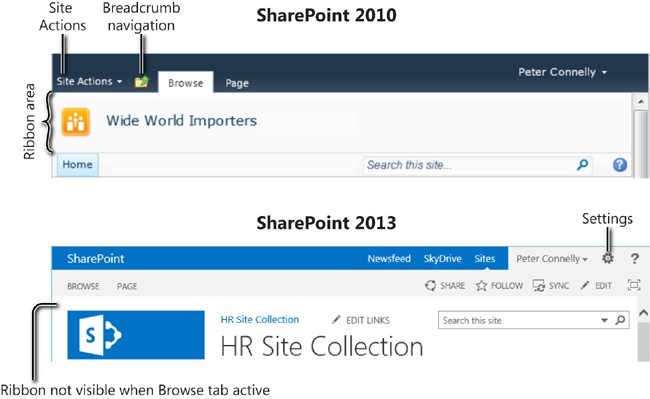Exploring Microsoft SharePoint 2013: New Features & Functions
Penelope Coventry
Published by Microsoft Press
I dedicate this book to my husband Peterwhere my heart lives.
Special Upgrade Offer
If you purchased this ebook directly from oreilly.com, you have the following benefits:
DRM-free ebooksuse your ebooks across devices without restrictions or limitations
Multiple formatsuse on your laptop, tablet, or phone
Lifetime access, with free updates
Dropbox syncingyour files, anywhere
If you purchased this ebook from another retailer, you can upgrade your ebook to take advantage of all these benefits for just $4.99. to access your ebook upgrade.
Please note that upgrade offers are not available from sample content.
Introduction
Welcome to Exploring Microsoft SharePoint 2013 . The purpose of this book is to point out both the new and improved capabilities of SharePoint 2013. As with previous versions of SharePoint, SharePoint 2013 contains many features with which you will be familiar; some features might not have changed at all; others will have changed, but at a high level will provide similar functionality that will not be new to you; and then there will be components that you will need time to fully understand before you can decide how they can benefit you and your organization.
With this version of SharePoint, Microsoft focuses on what a user can do, and therefore the focus of the improvements with SharePoint 2013 places users at the center of the SharePoint installation. In the coming months, as you learn more about SharePoint 2013, no longer will Microsoft talk about what SharePoint can do by using the six-segment SharePoint 2010 circle that consisted of the Sites, Communities, Content, Search, Insights, and Composites. You will hear that SharePoint 2013 provides a new way to work together and is the new collaboration platform. It will talk about how users can Share, Organize, Discover, Build, and Manage ideas and content in a SharePoint environment. Following is a description of each of these concepts:
Share . You can share when talking about your content and information, spreading it socially, spreading it online, spreading it easily across multiple places and devices where you might need to interconnect, whether it is on-premises, mobile, on a tablet in a cloud, or at a client site.
Organize . This is how you structure and categorize the information, whether it is a project, team, or information held in documents using SharePoint Office 2013 applications, such as Microsoft Outlook, Microsoft Project, and syncing your content in SharePoint to your desktop with Microsoft SkyDrive Pro.
Discover . This concept includes connecting people across your organization, the discovery of insights and answers through the use of Business Intelligence, and finding what youre looking for by using enterprise search. In this version of SharePoint, Microsoft has invested a great deal of effort into the integration of enterprise search.
Build . SharePoint 2013 has undergone major changes to the application model for how to build applications that are hosted on systems that are maintained by organizations on-premises, or when the systems are maintained outside of the control of an organization, in the cloud; how to publish these applications internally through a corporate catalog; and publishing them outside an organization as well as sharing them across on-premises farms and cloud-based farms through a public store. The new application mode also makes it possible for applications to be shared within office applications by using the new Windows 8 interface-based computers, laptops, ultrabooks, tablets, and Windows Phone. These are now introduced to the Microsoft Office 2013 applications.
Manage . SharePoint 2013 provides better support for managing SharePoint as a platform. It can be run in the cloud with Microsoft Office 365. It contains new archiving, eDiscovery, and case management capabilities that include SharePoint 2013, Microsoft Exchange Server 2013, and Microsoft Lync 2013.
More Info
You can find more details about Office 365 at office365.microsoft.com .
Microsofts aim is still for SharePoint to be a self-service product; that is, providing users with the ability to complete their tasks using no-code solutions by using the browser and Microsoft Office applications.
SharePoint 2013 consists of two products: SharePoint Foundation 2013 and SharePoint Server 2013. The exposure of two sets of functionality still exists in SharePoint Server, but is implemented using standard and enterprise client access licenses with a new licensing model. There is no longer a separate Microsoft FAST Search Server for SharePoint. You will find much of the functionality that was included in that product now incorporated as part of SharePoint 2013. Another change is that Microsoft Office Web Apps is a separate product and should be installed on servers on which SharePoint is not installed. Also, if your organization is a heavy user of SharePoint to automate business processes, there are changes with which you can distribute the workflow business logic onto servers where SharePoint is not installed.
As usual, the user interface has changed, but only slightly, as detailed in the following list (see also ):
The ribbon is still there but not automatically visible when the Browse tab is active.
Some of the components have moved. For example, the Site Actions tab has been replaced by a Settings icon that is now in the upper-right corner of the page.
Some components are no longer displayed. For example, the navigation up icon and the portal connection link are still placed on the master page, but the default CSS rules prevent them from being shown.
Hopefully, you will consider that these changes are minor, and as you pilot your upgrade to SharePoint 2013, the user feedback will confirm that it will not be necessary to formally retrain your users when you do upgrade.
Figure 1. Comparing the SharePoint 2010 user interface to the new SharePoint 2013 user interface.
Who this book is for
Although this book offers an overview of the new features of SharePoint 2013 from the perspective of an IT professional, it also introduces features that are important to the end user and business user. This should foster a solid understanding of why your organization might want to install or upgrade to SharePoint 2013 and help in the conversations you might have with these users.
This book does not provide step-by-step instructions on how to install or complete tasks by using SharePoint 2013 or provide an in-depth coverage or analysis of the new functions. Those details you can find in the following Microsoft Press books:
Microsoft SharePoint 2013 Plain & Simple by Johnathan Lightfoot, Michelle Lopez, and Scott Metker, which is aimed at end users who are new to SharePoint.
Microsoft SharePoint 2013 Step by Step by Olga Londer and Penelope Coventry, which is aimed at new and intermediate end users.
Microsoft SharePoint 2013 Inside Out

